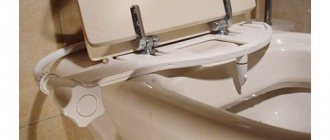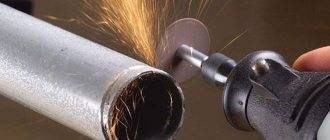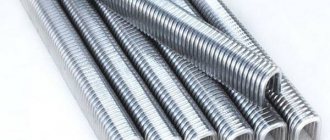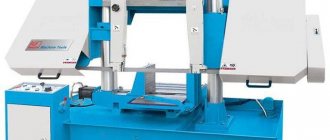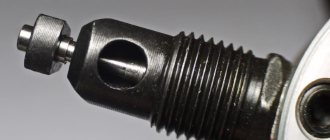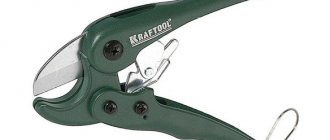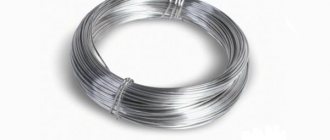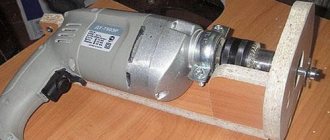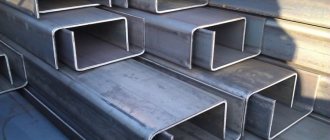An old hand drill - what you can do with it yourself
The hand drill is a trouble-free drilling tool that was extremely popular half a century ago. As soon as electric drills appeared, the demand for hand-held devices decreased, but did not disappear completely. Today, this tool is probably gathering dust in the garage, and everyone wonders what can be done with an old hand drill. You can try to sell the tool, but don’t rush, you will be able to get no more than 100 rubles for this tool, but by making useful homemade products, you will get a unique unit. Let us consider in detail what can be made from the tool in question.
Workbenches for power tools
To work with numerous devices, you will need to improve your workplace. For a home workshop or a car garage, a small, compact and universal workbench may be necessary. It is not so difficult to make it without the help of others; you just need to specifically improve your choice of what functions it is needed for. In general, it is more correct to make a workbench that can be used at any height, including on a table.
Then it will be possible to position the power tool comfortably and change its position if necessary. For work, it is recommended to use various hard woods; a common material is maple, which is easy to process and yet has the required hardness and strength. To register on the table, it is possible to attach comfortable legs or clamps to the installation. A workbench requires a vice; they are often used in work, which guarantees an improvement in its quality.
Making a ratchet from an old hand drill
The range of tool capabilities does not end there. You can also make a convenient ratchet wrench from an old and unnecessary hand drill. Moreover, it can be used as a regular wrench, that is, tightened by hand, or in tandem with a screwdriver.
To make the tool, you will need two bevel gears and a drill shaft, as well as steel tubes, plates and a welding machine. The process of making the tool is shown in detail in the video material. The result is a universal hand tool that is definitely stronger than modern ratchet wrenches.
As you can see, a hand drill is a very interesting tool from which you can make various homemade products, expanding your capabilities and also simplifying your work. If you come up with something else that can be done with a hand drill, be sure to share it, as it will help people use an outdated tool to do new things.
Safety precautions
When working with drill attachments, both purchased and homemade, be sure to follow the following rules:
- Be sure to wear protective gloves, goggles, or a clear face shield.
- Before starting work, check the tightness of the fasteners.
- Apply it evenly to the surface and increase the pressure gradually.
- Hold the drill firmly, preferably with both hands.
If you find an error, please select a piece of text and press Ctrl+Enter.
Today there are a huge number of
different attachments that are suitable for a conventional drill.
Thanks to this, it becomes a universal device that can replace many other expensive tools. For example, a grinding disc mounted on a drill will help eliminate the need to buy a grinding machine, and an accessory that can tighten a screw will replace a screwdriver.
Using various attachments, you can perform the following drill actions
- polishing;
- cutting;
- mixing;
- twisting;
- drilling various holes;
- milling.
If you choose the right nozzle, the result will be the same as if the work was done using special equipment.
Useful equipment is suitable for construction and various works on a summer cottage. The construction of a chicken coop, pigsty, cages and other outbuildings will not be possible without such equipment.
Electric drills with templates
Electric drills are often used simultaneously with special templates, which not only increase the reliability of drilling and subsequent installation, but also significantly stimulate processing. The drill guide attachment is made of metal and retains its own geometric qualities for a long period of time. For home use, you can purchase an affordable plastic sample, which, although not as strong as their metal counterpart, guarantees the highest accuracy of processing.
READ What is the difference between a rotary hammer and a drill?
The point of drilling templates is that their structure contains the dimensions and positions of the holes produced in the furniture design elements. Templates are available for drilling holes for attaching furniture hinges, inserting locks and constructing furniture ties. In such clamps there is not only a gap between the holes, but also a gap in which such holes should be placed from the edge of the workpiece. Homemade attachments used in a set with drills are also used to expand functionality.
Diagram of the milling table device
Attachments for power tools vary, but sometimes they are large scale, as is the case with milling machines and saws.
It is recommended to choose an improved table that will contain everything you need without exception for comfortable and non-hazardous work. The most common type is a milling table, made in the form of a large board with an opening for a router and a guide board. The scale of the worktop can be different, everything without exception depends on what kind of work will be carried out. The most ideal type is a table with legs of the required height. And the working and guide boards are made from chipboard sheets. In this case, vices and clamps can be taken into account on the surface. It is generally better to make table legs replaceable and provide a backup set.
For grinding and polishing
If you install the attachment on a drill for grinding and polishing, you can do the following work:
- Polish metal, wood and glass surfaces.
- Grind metal, as well as parts made from it.
- Remove corrosion, nicks, and scale from old coatings.
- Sand the edges of the glass.
The advantage of grinding attachments for a drill is that for such work there is no need to buy equipment, which has a fairly high price. And if you use attachments, you can cope with these tasks perfectly, the surface will remain perfectly smooth and even. Another positive thing is that they can be used to process hard-to-reach places that cannot be reached with other tools.
If you bought an attachment for a drill to process wood or other material, you should first read the information carefully, since for different types of accessories you will need to set different power and number of revolutions on the tool.
Sanding and polishing attachments are a simple rod on which sanding material, such as felt, foam rubber and sandpaper, will be attached.
Varieties
There are the following types of equipment :
These devices will be divided not only by type of construction, but also by degree of rigidity: they can be hard, super-soft, soft or embossed.
Cup
The cup attachment can be used to sand wood or other surfaces. This device consists of a rod onto which a cartridge and a cup-like body are attached. Inside the cup there is a large amount of bristles of varying hardness. Typically, such a nozzle is used to remove corrosion from old coating. There are also models that have very soft polishing materials: foam rubber, felt. The body is made of durable plastic or metal. If you bought a soft attachment for a drill, you can use it to polish the car’s surface.
Disc and plate
The disk equipment consists of a rod, grinding material and a housing. The difference from the previous model is the direction of the bristles. In this version, it will be directed from the center to the edges of the disk. You need to use this attachment very carefully, as you can easily ruin any coating. The bristles can be made of steel wire or brass.
The plate equipment is made according to the same principle as for grinding devices. But instead of a thread, it is equipped with a fixed or movable rod, which is fixed into a cartridge. Sandpaper must be secured using special Velcro.
It is recommended to buy a plate attachment that has a movable rod, with a rubber or soft thick layer between the Velcro and the base. Then it will be possible to adjust the required angle of inclination of the drill and smoothly follow the contour of the material being processed.
If the work is carried out using a rigid plate, it will be very difficult to control. And if you manage to make a slight tilt, it will noticeably go deeper into the surface of the product. As a result, the metal may simply be damaged. That is why it is better to use a firmly secured tool.
Fan, drum and end
The fan attachment looks like a small disk in the center, and petals of sandpaper or other similar material are attached to its edges. With the help of such a nozzle, you can process hard-to-reach places, cavities inside, or polish a hole, since the equipment will take absolutely any shape. The device is mounted in the drill chuck in the same way as in the previous types.
The drum equipment is made in the form of a rod with a cylinder, which is covered with sandpaper on top. It differs from the plate attachment in that the surface to be processed is located parallel to the cartridge, and not perpendicular. Glass, metal or wood can be processed. Typically used to sharpen the end of glass. There are different types of hard and soft depending on the purpose of purchase.
The end equipment looks like a rod, at the end of which the necessary processing material is fixed. This equipment operates on the principle of a file. With its help it is very easy to enlarge holes, as well as remove jags and make smooth edges.
An old hand drill - what you can do with it yourself
The hand drill is a trouble-free drilling tool that was extremely popular half a century ago. As soon as electric drills appeared, the demand for hand-held devices decreased, but did not disappear completely. Today, this tool is probably gathering dust in the garage, and everyone wonders what can be done with an old hand drill. You can try to sell the tool, but don’t rush, you will be able to get no more than 100 rubles for this tool, but by making useful homemade products, you will get a unique unit. Let us consider in detail what can be made from the tool in question.
Interesting facts about hand drill
Since its invention, the tool in question has been actively used for drilling wooden and metal structures, but such a device is not intended for drilling concrete. This is due to the fact that the device does not have a shock function, so it is almost impossible to drill a hole in concrete with such a tool. However, home craftsmen found a way out of the situation. While drilling concrete, periodic hammer blows were applied to the heel, which allowed the drill to advance into the material.
The main drawback of the tool is known to everyone who has ever used it. It involves the need for physical effort. If drilling wood required little effort, when working with metal and concrete, it took at least several hours to achieve results.
The operating principle of the tool in question is simple, and consists of transmitting rotational manipulations from the handle to the tool chuck through a pair of gear drives. Gears help increase the rotation speed of the chuck, but at the same time reduce the torque. The simple and uncomplicated design makes the tool in question not only repairable, but also durable. All that is needed to extend the service life is to monitor the amount of lubricant on the gears of the tool.
So, if you remember the design of the hand drill mechanism, as well as what it is, then it’s time to figure out what can be made from this tool.
Types of nozzles
Drill attachments vary in purpose:
- Polishing and grinding.
- Milling cutters for metal and wood.
- Sharpening.
- Drilling at an angle.
- Cutting.
- Drilling holes, crowns.
- Emphasis.
The parallel stop is used to adjust the depth of the drill. There are also special racks for drilling, thanks to them you can securely secure the tool and avoid injury.
The drill has more than just a drilling function . It can be used to make blind holes, for example, to install hinges in wooden furniture. A Forstner drill is perfect for this operation. The hole will be flat and the edges will be absolutely smooth. You can also use feather drills instead of Forstner.
What else can be made from an old hand drill - a quick-driver
The above describes the process of making a homemade product from an old two-speed drill, which has 4 gears. However, there are also single-speed devices that can also be used to make homemade products. This type of tool can be used to make a screwdriver that can be operated with one hand. This is very convenient when the other hand is busy. This device is called a quick-twist, and the principle of its manufacture is as follows:
- Take an old clamp or weld a U-shaped frame on which the homemade components will be located
- On one side, weld a fixed handle, as well as a movable trigger (made of steel with a thickness of at least 1.5 mm), which is connected to ¼-1/5 of the bevel gear from the tool
- On the other side of the U-shaped frame, a shaft is attached, on which a cartridge and a bevel gear are fixed, connected to the half-gear from the trigger
- When you press the handle, the cartridge moves due to the transmission of torque
- A bit of the appropriate type is fixed into the chuck, after which you can start working
READ DIY battery for 12V screwdriver
This homemade product has one drawback - it is necessary to disconnect the bit from the fastening element in order to return the handle to its original position. An example of such an invention is shown in the photo below.
Right Angle Drilling Template
As promised, we are talking about making a template from a simple board. Length doesn't matter here. The main task is to fit several holes on it at a distance of 5 cm from one another. The optimal thickness here will be 30–40 mm.
Using a square, mark 4–6 points along the center of the board. This action should be repeated on the reverse side. Extreme precision is important here. The marked points should be located perfectly opposite each other. Next, you should take a regular drill or screwdriver with a suitable drill bit. The task is this: you need to try to drill the board at all points as evenly as possible.
PHOTO: YouTube.com Try to drill each hole as perpendicular as possible
What are the advantages of using an old drill attachment for a screwdriver?
Having figured out what can be done from an outdated hand drill, you need to find out the advantages of this device. These advantages include:
- Torque increases 6-7 times. This means that the force from the screwdriver increases by so many times
- Ability to access bolts and nuts that are in hard-to-reach places
- To make the device, you will not need additional materials, since everything can be done with your own hands.
- No need to purchase additional consumables
In addition to the fact that the device can be used for screwing and unscrewing fasteners and large screws, the device also allows you to quickly tighten and unscrew them. You will definitely be satisfied with this device. How to make it is shown in detail in the video instructions below.
Fan, petal, drum and end
Fans resemble a lady's fan in shape, have a small disk in the middle, and the sandpaper is attached to it not in a solid piece, but in overlapping petals. This design is capable of significant changes in shape, which makes it possible to process the most inaccessible places, especially cavities and internal surfaces.
Fan nozzle
Drum ones resemble the paddle wheel of a pedal boat and the direction of the petals differs from the fan ones - they are perpendicular to the plane of rotation of the disk. They are used for processing hard materials, most often for grinding the edge of glass after cutting.
In the end type, an abrasive in the form of a cylinder, disk, cone, bowl or other body of rotation is attached to the end of the rod. They work similar to a grinding wheel. The devices are made small in size to make them easier to balance and to be able to get to hard-to-reach places.
Making a screwdriver attachment from a hand drill
Few people know what can be done from an old drill, so don't be in a rush to recycle or sell this invaluable tool. From it you can make a device for a screwdriver, which is designed for screwing and unscrewing various fasteners. These can be not only long self-tapping screws, but also bolts and nuts. The secret of this device is that you can make a very useful thing out of an old drill, which will allow you to get to hard-to-reach places and then unscrew the fasteners.
The principle of making an attachment or device for a screwdriver from a hand drill is to perform the following manipulations:
- First, we free the tool from unnecessary parts. To do this, remove the chuck from the tool, as well as the handle.
- The thrust heel is also dismantled, which will not be needed in the new device.
- The shaft on which the cartridge was located has a fairly large diameter. It will not be possible to install a shaft of this diameter into a screwdriver chuck, so let’s start grinding it down
- It is recommended to grind the shaft to reduce its diameter on a lathe. The use of an emery wheel or grinder for such purposes is not recommended, since the grinding will be uneven
- To grind a shaft on a lathe, it will first need to be removed from the tool. It's not difficult to do this. In the mechanism, near the bevel gear, which is mounted on the shaft, there is a hole with a cotter pin. This cotter pin must be knocked out, thereby disconnecting the gear from the shaft
- After grinding the shaft down to 8-10 mm on a lathe, it should be installed in place, not forgetting to pin it. The shaft is made of hardened steel, so before grinding it, it is recommended to do heat treatment (heat it with a blowtorch)
- The shaft is driven by a ball bearing, which can be lubricated to extend its life.
- The first part of the work is completed. The shaft that was ground off will be used as a transmission device on the new device. The working element on the device will be the shaft on which the handle is attached
- The second shaft has a specific hexagonal shape, which should also be machined so that socket heads or other attachments can be put on it. The simplest option is to make a square shape from the hexagonal shape of the end protrusion for securing the heads
- This can be done using a grinder and a cutting wheel. In this case, only heads for screwing and unscrewing bolted connections can be installed on such a shaft
- If you plan to use the device for other purposes, then threads can be cut on the shaft by first making it cylindrical and grinding it to the required size
- A drill chuck must be screwed onto the cut thread, into which you can install various attachments - bits, mixers, drills, cutters, etc.
- Please also note that to install the chuck on the secondary shaft of the device, you will also need to cut an internal thread for control fastening of the collet chuck
- To complete the manufacture of the device from an old hand drill, it is necessary to cut off the remaining part on which the thrust foot was attached
- After this, the homemade device is ready for use. All that remains is to fix it in the screwdriver chuck and test it
READ How to Choose a Drill for Home Use
The advantage of such a device is that it increases the torque. The screwdriver drives a small diameter gear, which transmits force to the larger gear. A small gear is attached to the large gear, and the force is transmitted to the second large gear, on which the secondary shaft is located, thereby reducing the rotation speed, which means increasing the torque. As a result, the device allows you to unscrew and tear off stuck and rusted bolted connections. However, do not forget that the main role is played by the screwdriver, which must have the necessary power reserve, otherwise its engine may suffer.
Attachments, tools and accessories for electric drills
An electric drill is an indispensable tool that can be found in almost every home; it is more than a motor with a chuck and a comfortable handle. It is the drill chuck that is the device that allows you to use it with advanced functions. The only exceptions are stops designed to fix the drill and accurately set the position and direction of movement.
Classification of nozzles and devices
Additional accessories and attachments for the drill can be divided into several groups based on functionality.
Groups of attachments and accessories for drills:
- stops and clamps that allow you to accurately position the tool and limit the depth of the holes;
- stop attachments for forming holes at different angles and at precisely adjusted right angles;
- nozzles with cutting functions for metals, wood, plastics, and panel materials;
- polishing and grinding attachments, wheels, brushes, abrasive tools;
- whisks for mixing solutions, paints, plaster mixtures, adhesives;
- pumps driven by an electric drill.
This list may not include all categories of attachments and devices, since the choice is huge, and new devices appear constantly. They are produced not only by industrial enterprises, but also by craftsmen.
Stops, frames, guides, machines
In this category you can find several types of devices, the task of which is either to limit the displacement of the drill relative to the drilling axis, or to make its translational movement as precise as possible in direction.
The design of most stops consists of two guides, drill position clamps, a frame itself, or a socket for installing the tool.
The guides can be supplemented with return springs, which repel the tool in the absence of human effort. Some stops have worm-type movement and locking mechanisms designed to move the tool slowly or set it in a specific position.
Stops have two clearly divided categories - those fixed to the drill and those that fix the drill itself. The second ones, installed on a table or workbench, give the drill the function of a moving part, a carriage of a drilling or grinding machine. Craftsmen also manage to make lathes. These are very specific devices that are not always used in everyday practice of using a drill. Their acquisition must be clearly motivated - either you are a master who makes a certain profit from the tool, or you are a collector or a lover of metalwork and turning.
The cost of stops varies widely, since there are many options for their design, level of complexity and functionality. The simplest device in this class is a parallel stop, which limits the depth of penetration of the drill into the material. Fixed machines are the most expensive part of this section, designed for professional use.
Advanced Drills
The main task of an electric drill is to drill holes, and the range of tools for this is very wide. In addition to conventional sets and single drills, in this class of devices you can find and use:
- Forstner drill with a centering point and wide side cutting surfaces. The tool allows you to make holes of small and medium diameter in wood without going through the material. Thanks to the tip, this drill can make holes for installing hinges, very precisely located in relation to the edges of the board;
- Spade drills for working with wood allow you to make wide, up to 60 mm, holes for installing fittings in solid and slab materials. The centering point and wide side stays are designed for precise recess positioning and limited depth. Drills have a characteristic flat configuration;
- a crown attachment is a complex shaped tool for sampling material from solid wood and chipboard, fiberboard, concrete and metal. The robust, wide cutting surface with a distinctive profile works as a cutter or group of cutters that selects holes up to 100 mm in diameter. In the center of the nozzle there is a drill, which defines the first, centering hole and guides the entire nozzle;
- drills for wood, concrete, metal - a wide range of different configurations, including especially durable Pobedit drills for working with concrete. In this group you can also find attachments for vibration and impact machines, which are similar in functionality to hammer drills.
Regarding the cost and the need to have the tools from this list, we can say that the choice of options is very large. The most expensive in the category will be a complex attachment for making wide holes - this is a professional tool that is not suitable for every drill.
Drill bits - home or professional
Feather drills and Forstner tools belong to the semi-professional category - they can be purchased and kept in a set, but it is worth considering that such specific devices do not need to be used in everyday practice. They will be useful for those who like to work with furniture, carpentry specialists, and for assembling doors.
It’s worth having a set of regular and pobedit drills in your home all the time, and the more diameter options there are, the better. In an apartment with concrete walls it is extremely difficult to do without a Pobedit drill. Attachments for rotary hammers and impact drills are considered in two versions - professional for builders and repairmen with powerful rotary hammers, and for home use, designed to work with a drill with extended functionality.
Angle adapters for drilling in hard-to-reach places
In this group of devices, gearboxes are most often found - gear and friction units that change the angle of rotation through the use of an additional mechanism and its own drill chuck. These are a kind of extensions that are installed on the drill and hold the drill in its chuck, making it possible to get into tight places.
Here it is worth thinking about choosing a device according to your capabilities.
The best option would be a nozzle with a variable angle, almost universal, which costs a little more than a fixed one, but makes it possible to get anywhere. To use such a gearbox, you will need a drill with increased power and good torque, but for a person who does all the housework himself, the device can be a good helper.
Cutting attachments for electric drill
In this category you can find at least two design options and possibilities for using devices for an electric drill - classic scissors for working with sheet materials and so-called “crickets”, which allow you to make even cuts and drill wide holes.
Scissor attachment
The scissors work reliably with steel up to 3 mm thick; they can be used to cut polycarbonate sheets, aluminum profiles, plastic, and roofing materials. The nozzle is selected according to force, the range for selection is wide, and the tool can be adapted to a professional powerful drill and to a home machine.
In a private house or garage, such a device will not interfere with an amateur craftsman, because working with sheet materials is always relevant. Powerful scissors will require the purchase of a drill with the appropriate parameters.
Cricket attachment or nibblers
A professional device for working with sheet and roofing materials, capable of cutting sheet steel up to 1.5 mm thick, stainless steel up to 1.2 mm, plastic, aluminum and copper up to 2 mm. The main advantage of cricket-type cutting shears is the ability to accurately cut sheets and drill holes of medium and large diameters.
The tool is indispensable for roofers who value not only precision and accuracy, but also high speed of work. Using a cricket requires certain skills.
Is it worth buying or keeping such a device in your home workshop?
Only provided that you know how to use it, and the tool itself is of high quality and expensive. A low-quality cricket will not give a good cutting effect, and you will only need to use it from time to time. The cricket makes it possible to perform artistic cutting of sheet materials.
Polishing and grinding tools for electric drill
This category consists of two large sections - polishing and grinding tools. These tools can be different in shape, since they can be used for working on surfaces, processing holes and finishing seams. Depending on the purpose, the material of the tool is selected.
Polishing accessories
Made from felt, felt, wool and foam rubber, sandpaper. Designed to bring surfaces, holes and seams to their final smooth state, giving a shiny effect.
Professional tools include attachments for processing holes and polishing discs - the most expensive ones, which allow you to bring various holes, including in car body parts, to the technologically required state.
Nozzles of this type are selected according to their main purpose and size. For a home workshop, a polishing brush is sufficient for finishing surfaces and seams. It is worth purchasing brushes of three sizes and degrees of hardness in order to be able to process surfaces made of different materials. The most common polishing attachment is made from medium-hard felt.
Grinding Accessories
These nozzles vary in design and base material to:
- abrasive fiber discs mounted on a support plate;
- petal heads made of sandpaper;
- carbide cutters for working on particularly durable materials with high precision;
- grinding stones for processing edges, seams, holes;
- abrasive polymer brushes for removing dirt from the surface of metal, wood, stone and other materials.
You can notice that in the group of tools there are exclusively professional products - these are cutters made of special hard alloys (aka cutters) and rod grinding stones. Their use at the household level is practically pointless.
In your home workshop and garage, it is worth having a set of flap brushes and several nylon brushes, as well as abrasive wheels with several grain sizes. A very important detail - when purchasing such devices, we must not forget that they are subject to rapid wear. Their cost is usually low.
Whisk attachments
Always presented in a wide selection. These tools come in a variety of shapes and sizes, as they are designed for mixing dry, liquid and viscous mixtures. Whisks are usually inexpensive, but you should choose them taking into account the work ahead - you can break the nozzle if you apply it to an excessively viscous solution.
Tools with characteristic vertical parts are suitable for working with dry mixtures; spiral and complex nozzles are designed for mixing solutions of varying densities.
For large-scale construction work, only a drill with a whisk will not be enough; in this case, it is better to use a construction mixer.
Pump attachments for electric drills
This is the most specific group of devices - this nozzle can be used for pumping liquids and solutions, but provided that you have a powerful drill. The pump performance is selected according to the situation, so it is extremely difficult to talk about a specific application.
The price range in this group is very wide, because the pumps are produced by Russian, Chinese, and European manufacturers. It’s hard to say whether to buy a pump attachment for a drill for a home workshop. In a private home or country house, it may be needed in emergency situations, but we must not forget that the time of continuous operation of the drill motor is limited, and the pump will have to be stopped periodically.
At the end of the review, we must note that when choosing attachments, it is necessary to take into account the design, power and functionality of the drill, your own skills in handling the tool and the need to strictly observe safety measures!
Making a machine for winding coils from a drill
What else can be made from an old hand drill that has been gathering dust in the garage for more than 10 years? Of course, you can make a simple device that will allow you to wind coils. You can wind not only threads and ropes, but also wire, for example, when rewinding electric motors.
The design of such a machine is very simple, and to manufacture it you will need to use the following devices:
- Vice - a fixed handle or tool stop located in a horizontal position is attached to them
- A block of wood of the appropriate size, which is located near the cartridge. This block acts as a stop, holding the tool in a horizontal position
- A reel or other devices are attached to the tool chuck, onto which material is wound - wire, rope, threads, etc.
A photo of such a device is shown in the photo below. If you attach a sharpening wheel to the chuck, the tool can be used as a hand sharpener.
Conductor made from a wooden block and its manufacture
To make a jig you will need a regular block, a pencil or marker, a hacksaw, a cutter and a square. First, you need to make markings on the block. To do this, use a square to draw a line along one of the edges. Next, it needs to be continued to adjacent sides using the same square.
On the adjacent edges, it is necessary to mark a distance of approximately half a centimeter and make a cut along the line. The half-centimeter marks marked on both sides will serve as a limiter. All that remains is to cut the chamfer so that you get a recess. Probably, a photo example will make it clearer how this work is done.
PHOTO: YouTube.com The chamfer is removed using a cutter or a stationery knife
That's all. Now you can make perpendicular holes very easily. But it is worth remembering that wooden devices are only enough for a few holes. Afterwards, the wood is erased by the drill and it will no longer be possible to guarantee a right angle.
PHOTO: YouTube.com And here is the newly made device in action
Drilling machine from hand drill
To prevent the old drill from sitting on a shelf in the garage, it is proposed to make a manual drilling machine from it. The advantage of such a tool is that you can always carefully make a hole in wood, glass, plastic, metal and even ceramic tiles using the appropriate types of drills. The manufacturing principle is simple, and lies in the fact that you first need to make a frame with a movable frame on which the hand tool will be installed.
- For manufacturing you will need a board, metal corners and cylindrical guides, for example, studs, on which you need to grind off the threads. The length of the pins affects the amount of tool movement
- First, a base is made to which pins are attached, located straight on one side of the wooden frame
- Holes are drilled in the corners for the studs
- These corners with holes are put on studs
- A wooden board of the appropriate size is attached to the corners, which will serve as the basis for securing the tool
- The drill is installed and secured to the moving part
- To ensure smooth movement of the bed, a latch is made that acts on the pin, thereby limiting the movement of the movable bed
The design of the device can be different, and it all depends on your own ingenuity, but the principle of creating such an invention with your own hands is shown in the photo below.
Sources:
https://moiinstrumentu.ru/staraja-ruchnaja-drel-chto-mozhno-iz-nee-sdelat-svoimi-rukami.html
Cup
In a cup nozzle, the working body has the shape of a bowl, on which more or less rigid bristles made of wire or plastic are attached. It is used for cleaning surfaces from rust, solid contaminants, welding slag and remnants of old paintwork.
Cup attachments for drill
There are also soft cup attachments with a working body covered with felt or foam rubber. They are used for polishing painted surfaces.
Using it requires developing a certain skill - when the axis of rotation deviates from the vertical or when the drill is held weakly, the cup has a tendency to move to the side, which can lead to damage to the polished surface or grinding of areas not intended for processing.
